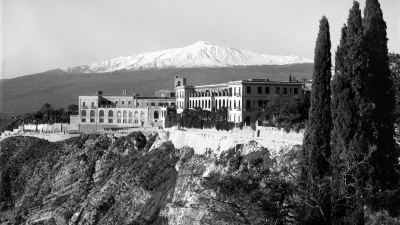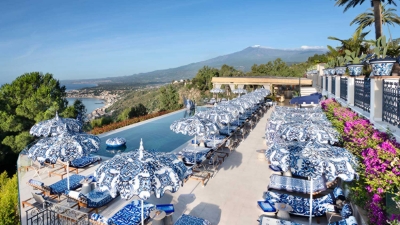The origins of San Domenico Palace in Taormina reach back to the year 1203, with the founding of the Dominican religious order by Saint Dominic in Toulouse, France.
One of the most important religious organisations in the history of the Catholicism, the order spread across Europe, leading to the establishment of a San Dominican convent in Taormina in 1374. The convent was first based in a small church. (At this point in history, a convent could imply a community of either monks or nuns.) Many religious communities were supported by rich patrons, and for the Dominicans in Taormina, their benefactor was Baron Damiano Rosso d’Altavilla.
Rosso made his first gift to the order in 1388 and converted to the monastic life himself. His largest gift was given in 1430, five years after his death, having bequeathed his residence to the religious community so that it could be turned into a convent. His home was the oldest in Taormina, situated next to the church of Santa Agata, in a beautiful location overlooking the Ionian Sea. The convent was established and remained a small community, never exceeding 40 members.
In 1866, more than 400 years after the death of Damiano Rosso, a new state law was passed, designed to suppress religious orders and confiscate their assets. Representatives of the new Italian state came to take possession of the valuable convent building. Just a single monk remained, Vincenzo Bottari Cacciola, and he did not want to abandon his centuries-old cell. The government officials actually had to use force to take the keys.
Offended by the arrogance of the state and convinced of his own righteousness, the monk decided to take action. He unearthed an ancient document that had been kept in secret by the brothers: the original will of Damiano Rosso. It stated that the property had only been lent to the Dominicans – meaning it could not be requisitioned by the state.
The monk took the will to a descendant of Damiano Rosso who was then able to reacquire ownership rights to the convent. The monk was permitted to remain in his cell for the rest of his life, satisfied at having punished the anti-clerical state.
The building’s new owner was Prince Cerami (for whom Principe Cerami restaurant is named), and it was his vision to transform the convent into a hotel. In 1896, he added a large wing in the Liberty architectural style, creating one of Europe’s first grand hotels.
At this same time in the late 1800s, Taormina was becoming a fashionable location for European tourists, attracted by the beautiful scenery and the town’s reputation for wild parties and a liberal sexual atmosphere. Capitalising on this reputation, the hotel soon found success, becoming one the most renowned destinations in the world.
Eventually the Cerami family rented the complex to a hotel management company called SGAS (Società Grandi Alberghi Siciliani), which at the time managed many of Sicily’s most prestigious hotels. Several years later, the family sold the hotel to SGAS.
Through the early 1900s, the hotel’s reputation grew, attracting nobility and famous writers and artists, such as King Edward VII of England, the second Baron Rothschild, Oscar Wilde and DH Lawrence. During World War II, San Domenico Palace was used as a headquarters by the German army, and as a result, it was bombed by the Allies in 1943. The convent’s church was almost totally destroyed and required reconstruction, using elements of the original architecture. (The church now serves as the Chiesa Ballroom.)
Upon reopening as a hotel around 1946, San Domenico Palace was the scene of many over-the-top parties, where the Allies mingled with the locals and danced all night to alternating Italian and American bands.
From the 1950s and beyond, San Domenico Palace welcomed the world’s most illustrious stars of stage and screen, including Greta Garbo, Ingrid Bergman, Audrey Hepburn, Elizabeth Taylor and Sophia Loren. In 2017, the hotel hosted the world’s political leaders for a G7 summit meeting.
Now, this iconic destination has begun a new era as a Four Seasons hotel, promising to continue its legendary reputation for a new generation.







